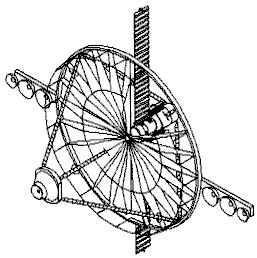
Home - Search - Browse - Alphabetic Index: 0- 1- 2- 3- 4- 5- 6- 7- 8- 9
A- B- C- D- E- F- G- H- I- J- K- L- M- N- O- P- Q- R- S- T- U- V- W- X- Y- Z
Globis

Globis 1991
Credit: NASA via Marcus Lindroos
Status: Study 1984. Gross mass: 21,000 kg (46,000 lb).
4 to 6 such satellites would make up a global information system, solving congestion problems in geosynchronous orbit. It was felt that only heavy platforms in an integrated system could operate high-volume optical inter-satellite data links.
Clearly the most ambitious geosynchronous communications satellite project was led by the Energia NPO (prior to its becoming RKK Energia) with the objective of launching enormous telecommunications platforms with masses of up to 20 metric tons in geosynchronous. First proposed in 1989 as a means of coordinating and consolidating numerous national communications systems, the idea of a high-cost, high-capacity geosynchronous satellite was received with muted enthusiasm. While providing one solution to the problem of overcrowding in the geosynchronous ring (reportedly, three platforms could replace 32 conventional geosynchronous satellites), the concern about a launch failure of the Energia booster or of an on-board support system (e.g., attitude control) which would cause the loss of the entire spacecraft was difficult to overcome.
Under the original Energia NPO and Energia-Marathon Association proposal, a Phase 1 system (1994-1997) would include three 17.8 metric ton platforms to meet USSR internal communications needs as well as communications with Europe and Asia. The 7.6- metric-ton payload would draw 12 kW from the total 16 kW on-board power supply to operate a host of transponders at 1.6/1.5 GHz, 6/4 GHz, 14/11 GHz, and 18/12 GHz through antennas ranging from 1 to 8.5 m in diameter, The design lifetime was rated at 10 years.
If successful, a Phase 2 system (1997-2000) might be deployed with 4-5 even larger satellites to form a Global Space System. A total platform mass of 20 metric tons could support a 9 metric payload package and a 24 kW electrical power supply system. Antenna dimensions would grow to up to 20 m in diameter, while transponder frequencies would increase to 60/50 GHz. To increase the payload capacity of the Energia launch vehicle, a two-stage liquid oxygen/hydrocarbon stage would be replaced by a single liquid oxygen/liquid stage. Although financing for the project was said to be in hand in 1992, the cancellation of the launch vehicle program ended the Globis satellite project. Notwithstanding this such platforms were still being proposed as late as October, 1994.
Family: Communications, Geosynchronous orbit. Country: Russia. Agency: Korolev bureau. Bibliography: 21.
Back to top of page
Home - Search - Browse - Alphabetic Index: 0- 1- 2- 3- 4- 5- 6- 7- 8- 9
A- B- C- D- E- F- G- H- I- J- K- L- M- N- O- P- Q- R- S- T- U- V- W- X- Y- Z
© 1997-2019 Mark Wade - Contact
© / Conditions for Use
